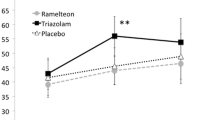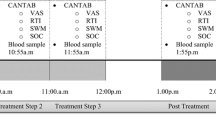Abstract
Eighteen healthy volunteers received mizolastine 5 mg, 15 mg or 45 mg, terfenadine 60 mg, triprolidine 10 mg or placebo in a 6-way crossover, double blind study. Following each dose, subjects performed a series of tests of cognitive function and psychomotor performance at 1, 3, 5, 8 and 24 hours post-dose. The test battery included critical flicker fusion, choice reaction time, tracking, Stroop and Sternberg memory tests and assessment of subjective sedation.
Sedative effects and a concomitant reduction in psychomotor and cognitive function were observed following triprolidine, terfenadine and the highest dose of mizolastine, 45 mg, e.g. triprolidine reduced CFF threshold by 1.5 Hz and increased reaction time by 50 ms, impairments comparable to those caused by blood alcohol concentrations of 50 mg%, the legal limit in many countries. Mizolastine 5 mg did not differ significantly from placebo and at 15 mg differed only at one test point at one time.
It may be concluded that mizolastine (5 mg and 15 mg) is free from disruptive effects on cognitive function and psychomotor performance, in contrast to terfenadine 60 mg, triprolidine 10 mg and mizolastine 45 mg.
Similar content being viewed by others
References
Danjou P, Molinier P, Berlin I, Patat A, Rosenzweig P, Morselli PL (1992) Assessment of the anticholinergic effects of the new antihistamine mizolastine in healthy subjects. Br J Clin Pharmacol 34: 328–331
Hindmarch I (1975) A 1,4-benzodiazepine, temazepam (K3917), its effect on some psychological limit of sleep and behaviour. Arzneimittelforschung Drug Res 11: 1836–1839
Hindmarch I, Parrott, AC (1978) The effect of a sub-chronic administration of three dose levels of a 1,4-benzodiazepine derivative, clobazam, on subjective assessments of sleep and aspects of psychomotor performance the morning following night time medication. Arzneimittelforschung Drug Res 28: 2169–2172
Hindmarch I, Parrott AC (1980) The effects of combined sedative and anxiolytic preparations on subjective aspects of sleep and objective measures of arousal and performance in the morning following nocturnal medication. Arzneimittelforschung Drug Res 30: 1025–1029
Hindmarch I, Subhan Z, Stoker MJ (1983) The effects of zimeldine and amitriptyline on car driving and psychomotor performance. Acta Psychiat Scand 68: 141–146
Keith J, Simons M, Singh C, Gillespie A, Estelle F, Simons R (1986) An investigation of the H1-receptor antagonist triprolidine: pharmacokinetic and antihistamine effects. J Allergy Clin Immunol 77: 326–330
Kirk RE (1968) Experimental design procedures for the behavioural sciences. Wadsworth, Belmont, California
McTavish D, Goa KL, Ferrill M (1990) Terfenadine. An updated review of its pharmacological properties and therapeutic efficacy. Drugs 39: 552–574
Meltzer EO (1990) Antihistamine- and decongestant-induced performance decrements. J Occup Med 32: 327–334
Nicholson AN (1979) Effect of the antihistamines, brompheniramine maleate and triprolidine hydrochloride, on performance in man. Br J Clin Pharmacol 8:321–324
Nicholson AN, Stone BM (1982) Performance studies with the H1-histamine receptor antagonists, astemizole and terfenadine. Br J Clin Pharmacol 13: 199–202
Okerholm RA, Weiner DL, Hook RH, Walker BJ, Leeson GA, Bidenbach SA, Cawein MJ, Dusebout TD, Wright GJ (1981) Bioavailability of terfenadine in man. Biopharm Drug Dispos 2: 185–190
Peck AW, Fowle ASE, Bye C (1975) A comparison of triprolidine and clemastine on histamine antagonism and performance tests in man: implications for the mechanism of drug induced drowsiness. Eur J Clin Pharmacol 8: 455–463
Rombaut NER, Bhatti JZ, Curran S, Hindmarch I (1991) Effects of topical administration of levocabastine on psychomotor and cognitive function. Ann Allergy 67: 75–79
Rosenzweig P, Therault J, Caplain B, Dubruc C, Bianchetti G, Fuseau E, Morselli P (1992) Pharmacodynamics and pharmacokinetics of mizolastine. Ann Allergy 69: 135–139
Sorkin EM, Heel RC (1985) Terfenadine. A review of its pharmacodynamic properties and therapeutic efficacy. Drugs 29: 34–56
Stern MA, Dunmore CJ, Théron, M (1993) A double blind comparative study of mizolastine (SL85.0324) 10 mg and placebo in the treatment of seasonal allergic rhinoconjunctivitis in adult patients. Eur J Allergy Clin Immunol 47: 177
Volkerts ER, Van Willigenburg APP, Van Laar MW, Maes RAA (1992) Does cetirizine belong to the new generation of antihistamines? An investigation into its acute and subchronic effects on highway driving, psychometric test performance and daytime sleepiness. Hum Psychopharmacol 7: 227–238
Warin RP (1984) The effects of large doses of H1-antagonist in urticaria. Br J Dermatol 111: 121
Author information
Authors and Affiliations
Rights and permissions
About this article
Cite this article
Kerr, J.S., Hindmarch, I. & Dunmore, C. The psychomotor and cognitive effects of a new antihistamine, mizolastine, compared to terfenadine, triprolidine and placebo in healthy volunteers. Eur J Clin Pharmacol 47, 331–335 (1994). https://doi.org/10.1007/BF00191164
Received:
Accepted:
Issue Date:
DOI: https://doi.org/10.1007/BF00191164




